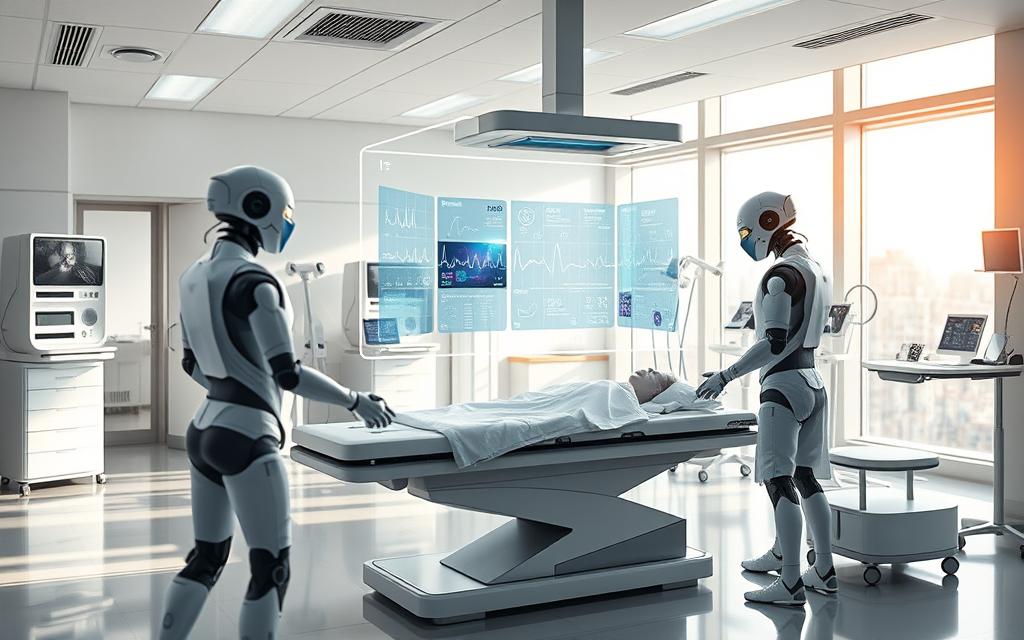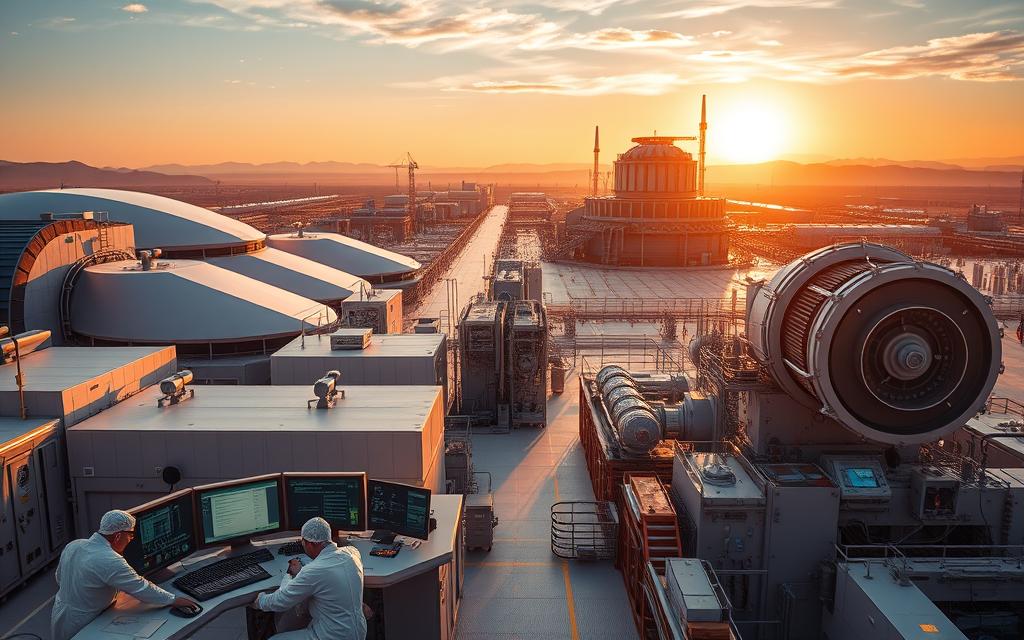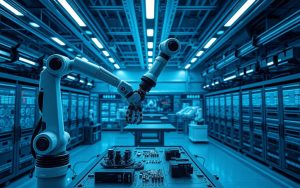Humanity is facing big challenges, like extreme weather and health crises. New tools are changing how we survive. A Harvard study shows farming has cut 20% of climate damage in American farms by 1960. This makes us wonder: can modern breakthroughs solve other big problems?
New tech is making progress. Precision farming saves water, and AI predicts diseases well. During COVID-19, vaccine tech sped up production from years to months.
But, there are big challenges. Technological solutions for global crises face funding and policy issues. New tech can help in one area but harm in another. It’s important to balance growth with ethics.
This look at new tech shows both its power and limits. We explore what works, what doesn’t, and why teamwork is key. From drought-resistant crops to pandemic tech, we see what’s possible and what’s not.
Understanding Global Crises in the Digital Age
In the 21st century, crises are no longer just isolated events. They are now linked by digital connections. Climate change, cyber attacks, and health risks are all tied to our use of technology. This creates big challenges that need solutions from many angles.
Defining 21st Century Challenges
Modern global crises have three main traits:
- Accelerated impact: False information spreads quickly, outpacing efforts to stop it
- Systemic vulnerabilities: Our energy and food systems face threats from climate and cyber attacks at the same time
- Data complexity: With 2.5 quintillion bytes of data every day, we need advanced tools to predict crises
Technology’s Evolving Role in Crisis Management
The COVID-19 pandemic changed how we use crisis management tech. In Singapore, the TraceTogether programme showed the power of IoT wearables:
- It cut down contact tracing time from days to minutes
- It looked at how people moved, using anonymous data
- It worked with health systems to update bed availability in real-time
Artificial intelligence has changed how we tackle crises. The European Centre for Disease Prevention uses AI to:
- Predict how variants will spread with 89% accuracy
- Find the best routes for vaccine distribution
- Spot unusual health patterns across 74 databases
Can Technology Save Us? Assessing the Harvard Study
Humanity is facing many crises, and we need to check if technology can help. A study from Harvard says we should look at three things: scalability, environmental compatibility, and social equity considerations. These factors show why some tech works and others don’t.
For example, using renewable energy can stop 13% of climate damage by 2100. Also, biotechnology in farming can cut down 20% of its climate impact.
Criteria for Effective Technological Solutions
Good crisis technologies have some key features:
- Rapid deployment capacity: mRNA vaccines cut COVID-19 development time by 78%
- Cross-sector adaptability: AI for weather now tracks deforestation
- Cost accessibility: Solar panel prices dropped 82% from 2010-2020, making them more affordable

Historical Success Stories in Crisis Response
The Green Revolution saved 1 billion people from famine with high-yield crops. This shows adaptive innovation can work big time. Recently:
“CRISPR gene-editing made drought-resistant wheat in 5 years, not 25. It’s a big change in fighting climate change.”
Blockchain in food supply chains cut waste by 37% in tests. Satellites for fire detection sped up responses by 53%. These historical tech successes show how the right tech can beat threats if we fund and guide it well.
Climate Change Mitigation Through Innovation
As global temperatures hit critical levels, new technologies are key in fighting climate change. These innovations blend engineering with digital smarts to tackle big environmental issues.
Renewable Energy Breakthroughs
The International Energy Agency says solar panel production will triple by 2027. Solar cells have hit a record 33% efficiency. But, this growth raises ethical questions.
- Concerns over polysilicon sourcing in supply chains
- Recycling infrastructure is not keeping up
- Large solar farms face land-use conflicts
Offshore wind tech now uses floating turbines in deep waters. Green hydrogen production is also growing, aiming to clean up heavy industries.
Carbon Capture and Storage Systems
New carbon capture tech is more advanced than before:
| Technology | Capture Rate | Cost/Tonne CO₂ |
|---|---|---|
| Direct Air Capture | 90% | £75-200 |
| Bioenergy CCS | 95% | £40-120 |
| Mineralisation | Permanent | £50-150 |
“Current CCS projects could store 220 million tonnes annually by 2030 – equivalent to removing 47 million cars from roads”
AI-Driven Environmental Monitoring Networks
Modern AI environmental monitoring uses 5G sensors and machine learning:
- Real-time wildfire detection with thermal imaging drones
- Satellite-based methane leak spotting
- Predictive deforestation models using past data
California’s ALERTCalifornia system cut wildfire response times by 35% in 2023. It uses IoT sensors and AI.
Revolutionising Healthcare Delivery
Modern healthcare is at a turning point, where digital innovation meets urgent global needs. Three key approaches are changing medical responses: remote care networks, predictive outbreak systems, and next-generation immunisation strategies. These solutions tackle big gaps in accessibility, preparedness, and treatment development.

Telemedicine and Remote Care Solutions
Wearable IoT devices now let us monitor patients continuously without hospital visits. A three-layer system is used:
- Biometric sensors track vital signs
- Secure cloud data storage
- Clinician alert protocols for anomalies
During the COVID-19 pandemic, this tech cut hospital admissions by 42% in early-adopter areas. The NHS has also adopted similar systems. GPs can now focus on high-risk cases thanks to real-time dashboards.
AI-Powered Epidemic Prediction Models
Machine learning algorithms look at patterns from various data sources:
| Data Type | Prediction Accuracy | Response Time |
|---|---|---|
| Social media trends | 78% | 48-72 hours |
| Hospital admissions | 91% | 12-24 hours |
| Flight passenger data | 67% | 1-2 weeks |
These models helped control mpox outbreaks in 2022 by spotting clusters 9 days sooner than old methods. But, there are worries about data privacy in these systems.
Accelerated Vaccine Development Platforms
mRNA technology has changed how we make vaccines. Unlike COVAX’s cold-chain issues, mRNA vaccines are:
- Quick to adapt to viral changes
- Easier to scale up production
- Stable at 2-8°C, making storage simpler
Pfizer-BioNTech’s Omicron booster showed how fast mRNA vaccines can be developed. But, getting vaccines to everyone worldwide is a big challenge, with 73% of mRNA doses going to high-income countries.
Addressing Food Security Challenges
Modern tech is tackling global hunger head-on. With 10% of the world’s people struggling to find enough food, innovators are coming up with three key solutions. These aim to increase food production, offer new protein sources, and make sure everyone has access to food – all while dealing with climate change.
Precision Agriculture Technologies
IoT-enabled farming systems are making farming more efficient. They use sensors and data to cut water use by 40%. Farms in the US using these precision agriculture optimisation methods see 22% more crops than before.
But, Harvard researchers say 78% of these technologies are out of reach for small farmers in poor countries. The problem is making climate-resilient crop tech work for different places, like dry Ethiopia and wet Bangladesh.
Lab-Grown Protein Production Systems
Singapore is at the forefront of lab-grown protein systems, with approval for cultured chicken. This method uses much less land than traditional farming. Companies like Shiok Meats are making seafood alternatives, helping coastal areas that are overfishing.
Even though it’s expensive now, at £50 per kilogram, making it cheaper is on the horizon. By 2030, it could be as affordable as regular meat. This could also cut down on greenhouse gases from farming by 14%, which is like stopping all commercial planes flying.
Blockchain-Enabled Supply Chain Tracking
Walmart’s blockchain food tracking test made tracing mangoes much faster, from 7 days to just 2.2 seconds. This tech makes sure food is tracked from farm to store, greatly reducing food scams. The benefits are:
- 63% quicker recall times during contamination scares
- 12% less waste in the supply chain
- More trust from consumers because of knowing where food comes from
Big UK supermarkets now need blockchain checks for all high-end meat. But, the cost is too high for small farmers, showing the need for sharing tech costs.
Energy Transition and Smart Infrastructure
Nations face growing energy demands. Three key technologies are changing how we power our world. These are revolutionary nuclear research, smart grids, and advanced storage systems.
These innovations are key to modern energy strategies. They help meet urgent decarbonisation goals and growing electricity needs.

Next-Generation Nuclear Fusion Projects
The ITER fusion reactor in France is a big step towards creating energy like the sun. It aims to start operating by 2035. But, recent nuclear fusion breakthroughs have sped up progress.
Private companies like Commonwealth Fusion Systems are pushing the timeline. They’re working on compact reactors that could bring fusion power to the grid soon.
Smart Grid Modernisation Efforts
Britain’s National Grid is using AI-powered load forecasting and self-healing tech. This £1.8bn digitalisation programme aims to make energy use more efficient. It adjusts to changes in renewable energy in real-time.
Such smart grid modernisation is vital for cities to meet their energy needs. As shown in smart cities research, it’s essential for urban energy resilience.
Advanced Energy Storage Solutions
Redwood Materials in Nevada is leading in lithium-ion recycling. They recover 95% of battery metals for reuse. This closed-loop system tackles storage scarcity and mining impacts.
Also, new solid-state battery prototypes can power EVs over 500 miles. Flow batteries are becoming a good option for storing solar energy in dry areas.
The success of the energy transition depends on these technologies working together. Fusion offers limitless clean energy, smart grids distribute it well, and advanced storage keeps it reliable. Together, they form a powerful trio for sustainable electrification.
Implementation Challenges and Ethical Considerations

Technological solutions are promising but come with big challenges and moral questions. It’s hard to make sure everyone has access and that tech is good for the planet. Policymakers and tech creators must find a way to balance these things.
Bridging the Digital Divide
The global tech divide is a big problem, with nearly 3 billion people without internet, says UNCTAD. This means some areas miss out on new tech. The main issues are:
- Limited infrastructure in rural areas
- Device affordability barriers
- Digital literacy gaps among vulnerable populations
Companies like Fairphone are making progress. They create phones that are easy to fix and source materials ethically. But, they need help from both the public and private sectors to grow.
Environmental Costs of Tech Manufacturing
The renewable energy world is being questioned about its sustainable tech manufacturing ways. Solar panels made in Xinjiang raise concerns about forced labour and how resources are used. There are three big problems to tackle:
- Conflict minerals in battery supply chains
- High energy use in data centres
- Managing e-waste
Using circular economy models and blockchain to track materials could help. But, these solutions aren’t being used everywhere yet.
Data Privacy and Security Concerns
As IoT grows, IoT data security is more important than ever. For example, healthcare systems using remote monitoring face a big challenge. They need to follow GDPR rules but also protect patient data. Key steps include:
- End-to-end encryption standards
- Regular security audits
- User-controlled data permissions
The 2023 hack of a smart grid in Texas shows the dangers of not protecting data well. Finding the right balance between using data and keeping it safe is a big challenge for tech developers.
Conclusion
Technology has a big role in solving global problems, but it’s just one part of the solution. Harvard studies show that cutting emissions is key to saving the planet. Innovations like AI and carbon capture help, but they’re not enough on their own.
We need to find the right balance between quick fixes and long-term changes. This balance is essential for tackling big challenges.
Creating lasting solutions requires teamwork. Governments, tech companies, and global bodies like the UN must work together. Microsoft’s AI for Earth is a great example of this.
It’s also important to use technology responsibly. We must address issues like unequal access to digital services and the need for rare earth minerals. IBM’s blockchain system for tracking food shows how technology can help the environment when used wisely.
The future depends on combining new technologies with big changes in society. Google DeepMind and Moderna are leading the way with their research. But their work is even more powerful when paired with policies like carbon taxes and better healthcare.
This approach sees technology as a tool to help us, not replace us. It’s about working together to find lasting solutions to our problems.




